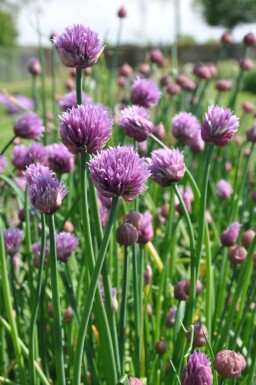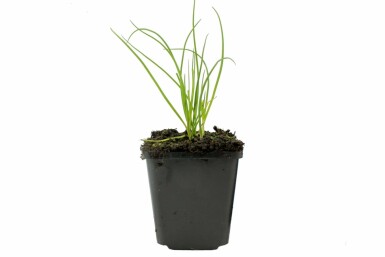

30cm




The Allium genus, with its diverse array of species, is a remarkable group of plants that grace gardens across the northern temperate zones of Europe, Asia, and North America. These plants, commonly known as onions, are renowned not only for their culinary applications but also for their ornamental value. Featuring a palette of striking purples and pinks, their globular flower heads rise above their green foliage, adding a burst of color and a delightful fragrance to any garden. The Allium's distinctive blooms make them a favorite among gardeners seeking to create a visually stunning and aromatic landscape.


30cm




The genus Allium, commonly referred to as onions, encompasses a wide array of plants known for their layered growth and distinctive fragrance. This remarkable genus includes a variety of species that are not only culinarily significant but also highly regarded for their ornamental value. Alliums are celebrated for their striking spherical flower heads that bloom in shades of purple and pink during the late spring and early summer months, adding a burst of color to garden borders, group plantings, and even container gardens.
Recognized for their clump-forming growth habit, Alliums are a delightful addition to any garden, providing structure and interest. With a natural distribution across the northern temperate zones of Europe, Asia, and North America, these plants have adapted to a range of climates and settings.
Alliums are cherished for their vibrant blooms and ease of care. Here are several of their most compelling attributes:
To ensure your Alliums thrive, consider the following guidelines:
By incorporating these easy care tips into your gardening routine, you can enjoy the charming display of Alliums throughout the growing season. Their structured form, attractive blooms, and delightful fragrance make them an excellent choice for gardeners seeking a low-maintenance yet high-impact plant.
Embrace the essence of culinary delight with Allium schoenoprasum, commonly known as chives. These elegant perennial herbs not only add a refined touch to garden spaces with their delicate purple blooms but also offer a subtle onion flavor that enhances a myriad of culinary creations. Perfect for those who appreciate both aesthetic beauty and gastronomic excellence in their herb garden.
We would like to provide some tips on how to plant and care for a Allium. By following these tips, you can be sure to enjoy your Allium for a long time.
For optimal growth, this species thrives best when situated in full sun to partial shade. A well-drained soil is paramount to accommodate its root system, though it is adaptable to a variety of soil conditions. Ensuring a location that receives ample sunlight will encourage the most vibrant display of its characteristic purple blooms during the summer months. When considering planting in groupings or as border embellishments, allow for enough space for clump formation, which is a natural growth habit of this plant. The site should also offer moderate water availability to meet its hydration needs.
For successful establishment, ensure that the soil is well-drained, as this species thrives in such conditions. Planting these bulbs in pots or directly in the ground can be done during a period where the risk of frost is minimal, ideally in the spring or autumn. Place each specimen in a location receiving full sun to partial shade to encourage robust flowering. When planting, maintain a sufficient distance between the bulbs to allow for clump formation and adequate air circulation, which is vital for healthy growth. Water moderately after planting and maintain average moisture levels as the bulbs establish and develop.
To ensure robust growth and vibrant blooms in Allium species, a balanced approach to fertilization is crucial. These plants benefit from a slow-release fertilizer applied in early spring, as new growth begins to emerge. A formula that is high in phosphorus, the middle number on a fertilizer package, will encourage generous flowering.
It is not necessary to fertilize Alliums again during the growing season unless they are grown in containers, which may require a mid-season boost due to nutrients being more readily flushed out with frequent watering. In such cases, a diluted liquid fertilizer can be applied every few weeks during the growing season to maintain plant vigor and bloom quality.
Remember, over-fertilization can be detrimental, leading to lush foliage at the expense of flower production, so it is essential to follow recommended application rates.
Pruning for Allium species is minimal given their growth habit. Once the flowering period concludes, typically by the end of June, it is best to remove the spent flower stalks to maintain a tidy appearance and prevent self-seeding, which is not an issue since these plants are not fruit-bearing. As the foliage begins to yellow and die back, which is normal for this deciduous plant, you can also trim it away. This helps direct the plant's energy back to the bulbs for the next season's growth.
The Allium species, with its fragrant blooms, requires consistent moisture to thrive, particularly during the growing season. Ensure that the soil remains well-drained but does not dry out completely, as this could stress the plants. During extended dry spells, it is crucial to water these plants regularly to maintain an even level of soil moisture. Over-watering should be avoided, as the bulbs are susceptible to rot in overly wet conditions. After flowering, water can be reduced as the foliage begins to die back naturally, preparing the plant for dormancy.
Cultivating Allium in pots offers a unique advantage for gardeners with limited space. These versatile plants, when placed in containers, allow for better control over soil quality and moisture levels, ensuring optimal growing conditions. Additionally, Allium species can serve as a wonderful aesthetic touch to patios and balconies, with their intricate blossoms that add a burst of color and structural interest to any outdoor space. Moreover, their presence can enhance the flavor of home-cooked dishes with freshly harvested, aromatic bulbs.
To propagate Allium through division, it's best to undertake this process in either spring or autumn. Carefully lift the plant from the soil, ensuring you preserve the integrity of its root system. Once removed, gently separate the bulb clumps into smaller sections. Be sure to leave a good amount of roots attached to each division to facilitate healthy regrowth. Replant the divisions promptly, situating them at the same depth they were originally growing to maintain their robust nature. This method not only multiplies your Allium collection but also invigorates the plants, promoting more abundant blooms in the following season.
Allium, with its striking globular blossoms, is a splendid addition to any garden. These ornamental onions captivate onlookers with their vibrant shades and architectural height, making them perfect for creating focal points in floral arrangements and borders. Their easy care and long-lasting blooms are an added delight for any gardener.
